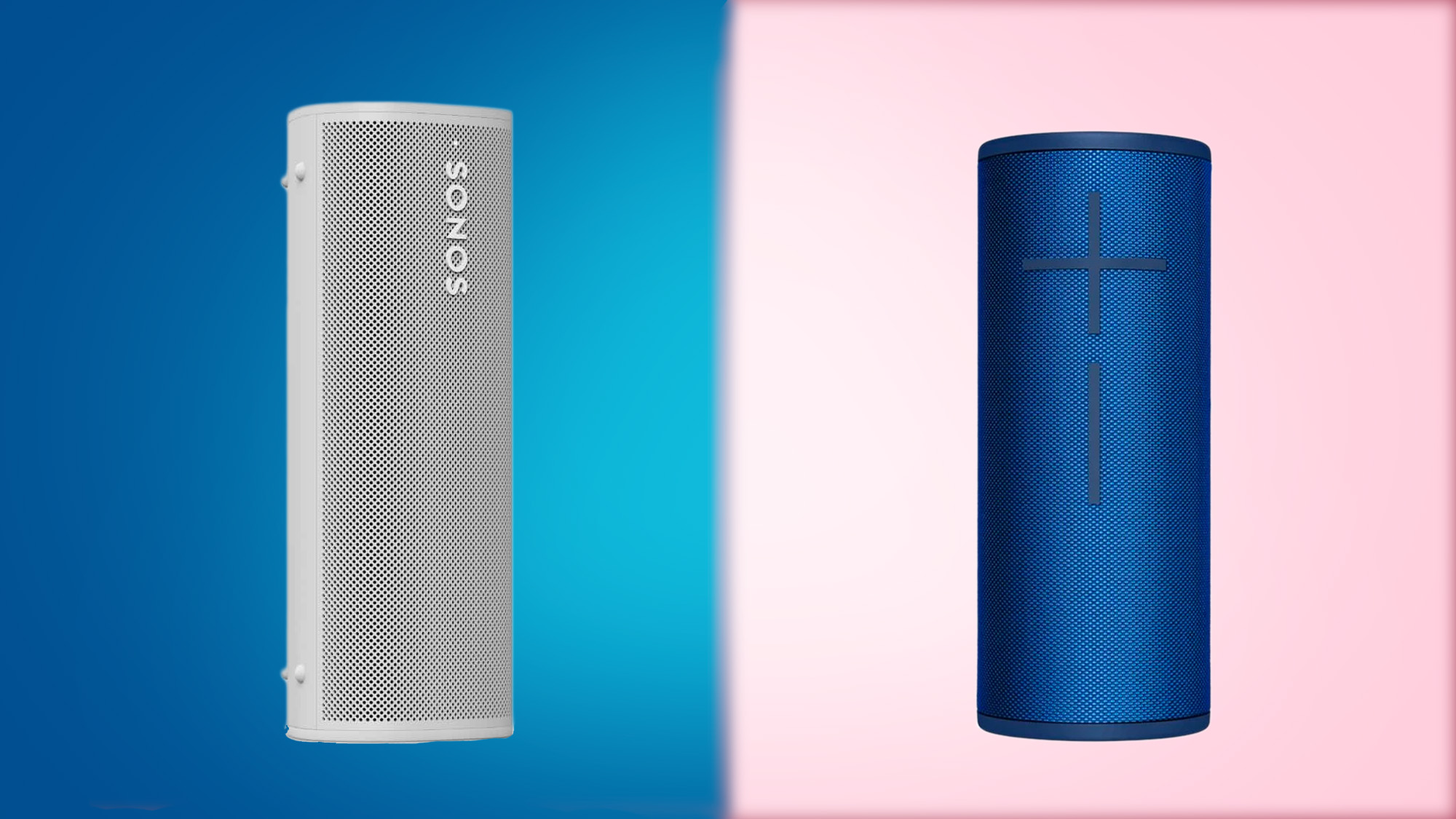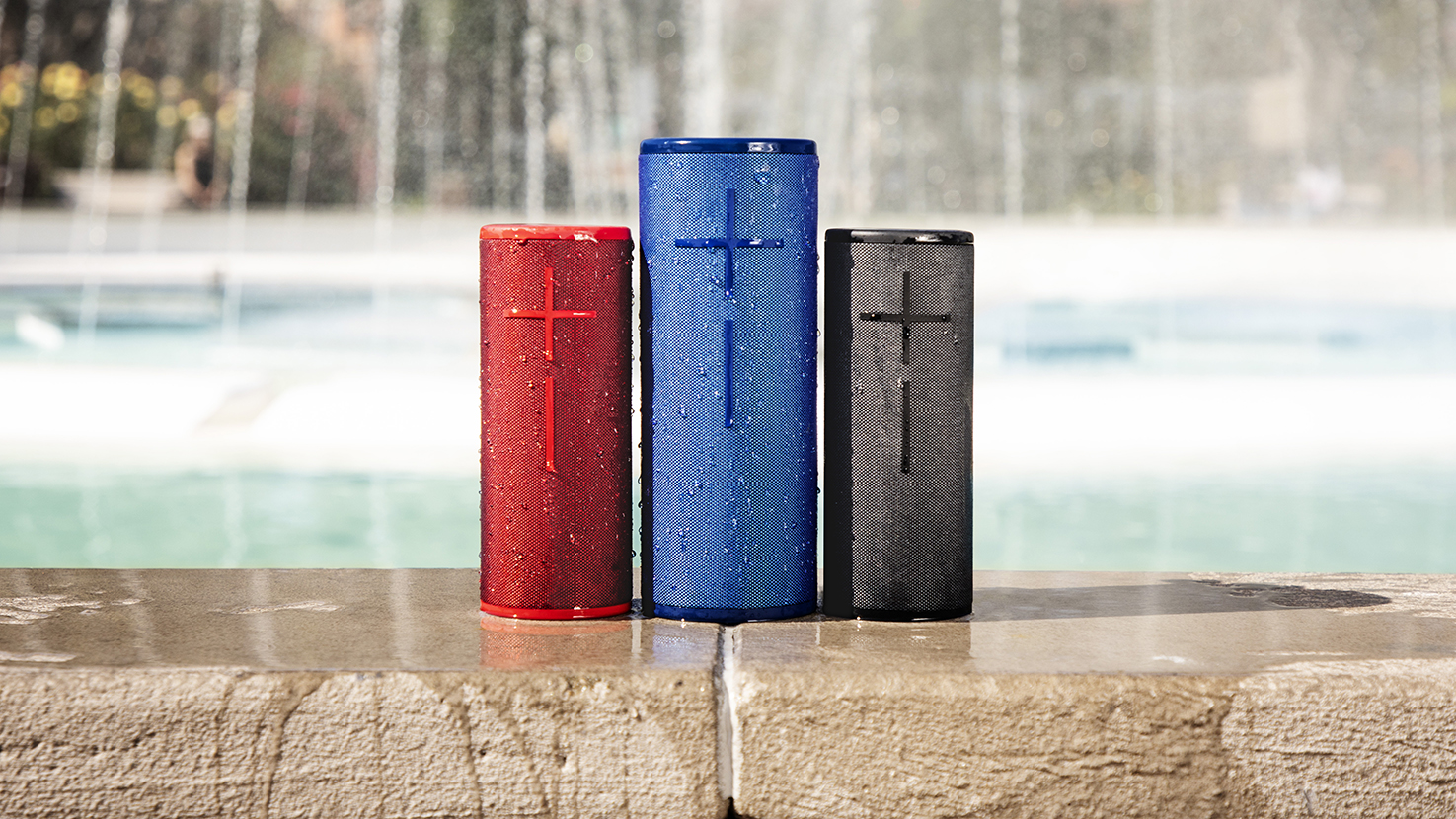Sonos Roam vs UE Boom 3: how do the Bluetooth speakers compare?
Find out how the Sonos Roam stacks up against the UE Boom 3

Bluetooth speakers are an essential bit of kit for any music lover who wants to take their tunes on the go – and the Sonos Roam is our pick for the best portable speaker you can buy today.
Its mixture of Bluetooth and Wi-Fi connectivity, integration with the wider Sonos ecosystem, and surprising volume levels meant that the Roam impressed us - but how does it stack up against one of our favorite Bluetooth speakers, the Ultimate Ears Boom 3?
On paper, the UE Boom 3 is a far simpler device, only offering Bluetooth connectivity. However, its rugged design, great app integration, and lower price will make it a very attractive prospect for adventurous types.
If you want to read about each speaker in depth, head to our Sonos Roam review and Ultimate Ears Boom 3 review. Otherwise, read on to find out how these portable speakers fare in the Sonos Roam vs Ultimate Ears Voom 3 showdown.
Sonos Roam vs UE Boom 3: price and availability
The Sonos Roam is available to buy for $179 / £179 / AU$299; that's $20 / £20 / AU$20 more than its original launch price in April 2021, after Sonos announced a nearly product-wide price hike.
That price tag still makes it the cheapest Sonos speaker to date in the US and UK – though the UE Boom 3 is cheaper still.
The UE Boom 3 is available to buy for $149.99 / £129.99 / AU$199.95, which is around $30 more expensive than its predecessor, the UE Boom 2. However, as the speaker launched in 2018, it’s often discounted to prices in the region of $120 / £100 / AU$150.
Sign up for breaking news, reviews, opinion, top tech deals, and more.
Still too pricey? There are plenty of more budget-friendly Bluetooth speakers on the market, including the Anker Soundcore Flare, the UE Wonderboom 2, and the Urbanista Brisbane.
Sonos Roam vs UE Boom 3: design
In terms of shape and size, the Sonos Roam and the UE Boom 3 look fairly similar, with slim cylindrical builds and rubberized end caps.
However, only the UE Boom features a wraparound fabric grille for 360-degree music playback. The Sonos Roam’s drilled grille is limited to the front of the speaker, though its shape means you have a little more flexibility as to where you place it – you have the choice to position it horizontally for stability on uneven ground or vertically for a smaller footprint, with its triangular shape funneling sound upwards.
On the left end of the Sonos Roam (when oriented horizonatlly) is a control panel with tactile buttons for adjusting your music playback, with each end cap coming in a concave shape to protect the Roam from bumps and scrapes.
You can also find control buttons on the top of the UE Boom 3, with an on/off button and a ‘magic button’, which can be used to pause, play, and skips tracks. You can also use the magic button to directly access your playlists from a select few music providers – to do this you will need to set this feature up in the accompanying Megaboom app.

Both waterproof speakers come with an IP67 water-and-dust-resistance rating, making them rugged enough to withstand the elements, with the ability to survive for 30 minutes in up to three feet of water.
The UE Boom 3 has an extra feature for when you head to the pool or beach: it can float. It’s certainly the more rugged-looking of the two speakers, coming in a range of colors (with the ability to personalize the finish if you wish), with a fabric grille that’s designed to be super durable, as it was originally engineered for motorcycle jackets and fire equipment.
By comparison, the Sonos Roam looks more like a traditional home speaker – and that’s exactly what the company was going for, aiming to make a portable speaker that looks great in the home as well as outdoors.
Like all Sonos products, the new Roam comes in matte black and white color options, retaining the brand’s minimalist look and penchant for sleek lines.

Sonos Roam vs UE Boom 3: audio performance
In spite of its small size, the Sonos Roam delivers a powerful sonic performance with remarkably prominent bass. Inside the speaker are two class-H amplifiers, with a high-efficiency motor that Sonos says increases the power and range of the audio output, as well as a custom racetrack mid-woofer, and a tweeter.
You can adjust the Roam’s EQ settings via the Sonos S2 app. Sonos is also reprising its Automatic Trueplay tuning technology for the Sonos Roam, allowing the speaker to adjust its sound output based on its orientation, location, and content.

Meanwhile, audio performance isn’t the UE Boom 3’s strong point. With a maximum volume of 90 decibels, this little speaker certainly packs a punch, and it has two 2-inch drivers and two 4-inch passive radiators for room-filling sound.
However, we found that the mid frequencies sounded recessed, and there was a lack of clarity in the trebles.
Saying that, the bass sounded decent, and the soundstage felt wide and spacious, with good frequency separation. You can also amend the default EQ settings in the dedicated app – it comes with four different presets ‘The Standard’, ‘Cramped Spaces’, ‘Voices’, and ‘Bass Jump’. Swapping between these presets didn’t have a huge effect on the audio output, although you can create your own custom equalizer settings with the adjustable tuner. Simply move the sliders up and down on the bass, mid, and treble tuners until you find a sound you’re happy with.
As we mentioned, the UE Boom 3 offers 360-degree sound, so it might be better placed in the middle of a circle of friends than the Sonos Roam.

Sonos Roam vs UE Boom 3: connectivity
Connectivity is where the Sonos Roam and the UE Boom 3 differ most dramatically. While the UE Boom is solely a Bluetooth speaker, the Sonos Roam comes with both Bluetooth and Wi-Fi connectivity, so you can use it on the move and at home as part of a wider multi-room Sonos system.
Let’s look at the UE Boom 3 first.
While Ultimate Ears doesn’t specify which Bluetooth version it uses, the UE Boom 3 has a wireless range of up to 150ft / 45m, and can pair with up to eight devices, with the ability to connect to two devices simultaneously.
You can pair two UE Boom 3 speakers for stereo sound, and up to 150 (no, reall7) Ultimate Ears speakers in mono. We found the connectivity to be very good when we tested the Boom 3, with no significant pairing or dropout issues.
The Sonos Roam, on the other hand, comes with Bluetooth 5 and Wi-Fi 5 (802.11ac) connectivity, with the ability to pair two Roams for stereo sound, and it can be integrated into a Sonos speaker system over Wi-Fi.
Automatic Switching between Bluetooth and Wi-Fi means the Sonos Roam will automatically connect to your Wi-Fi network when in range, and re-pair with your phone when you’re out and about. Unfortunately, we were unable to test this due to the issues we encountered with the Sonos Roam.

Another feature introduced with the Sonos Roam is Sound Swap, which allows you to ‘throw’ the music from your Sonos Roam to the nearest Sonos speaker available, using ultrasonic frequencies to communicate with each other. All you have to do is hold down the play button on the top of the Roam, and it works incredibly well.
The Roam works with lots of connected audio sources, online or stored on a local network. If you want to fire up a playlist on Spotify using Spotify Connect, that’s just as simple in-app as playing something you’ve ripped to a networked storage device yourself. Just fire up the Sonos app, and once set up and connected to the internet, all your sources appear over Wi-Fi.
The Sonos Roam also comes with the Alexa and Google Assistant voice assistants built-in, allowing it to double up as a smart speaker. This means you can control music playback with your voice, and use it to set reminders, control smart home devices, or access your calendar.
So, the Sonos Roam has far more flexibility when it comes to connectivity than the UE Boom 3 – though if you’re looking for a simple Bluetooth speaker, the Boom 3 might be the way to go.

Sonos Roam vs UE Boom 3: battery life
The UE Boom 3 offers an impressive 15 hours of playback from a single charge, coming with a micro-USB to USB-A cable in the box. You’ll have to provide your own USB-wall adaptor, though.
You can buy a dedicated charging dock for an additional $40 / £35 / AU$50, which is handy if you want to keep the UE Boom in a particular area of your home.
Meanwhile, the Sonos Roam has a claimed battery life of 10 hours, coming with USB-A to USB-C connector in the box – again, you’ll need your own adaptor.
It works with any Qi-certified wireless charging devices, but Sonos does sell its own charging base with magnets to hold the speaker in place, which is available to buy for $49 / £44 / AU$79.
Additionally, Sonos says that the Roam can last up to 10 days in sleep mode – it’ll automatically go into sleep mode when you stop playing music.
Takeaway
Whether you should buy the Sonos Roam or the UE Boom 3 comes down to what you’re looking for from a portable speaker.
Do you need an extremely rugged speaker you can chuck in your bag, float in the pool, and use for 360-degree sound? The UE Boom may be for you, and if you can get it at a discount, it’s much cheaper than the Sonos Roam, too.
However, if you want a speaker that can really bridge the gap between indoors and outdoors with Wi-Fi and Bluetooth connectivity, already have other Sonos speakers at home, and you want to be able to control your smart home devices, the Sonos Roam is probably your best bet.
- Check out the best wireless speakers you can buy today

Olivia was previously TechRadar's Senior Editor - Home Entertainment, covering everything from headphones to TVs. Based in London, she's a popular music graduate who worked in the music industry before finding her calling in journalism. She's previously been interviewed on BBC Radio 5 Live on the subject of multi-room audio, chaired panel discussions on diversity in music festival lineups, and her bylines include T3, Stereoboard, What to Watch, Top Ten Reviews, Creative Bloq, and Croco Magazine. Olivia now has a career in PR.